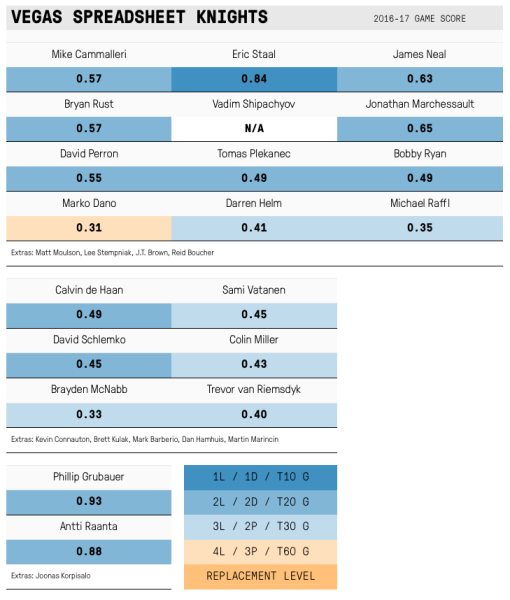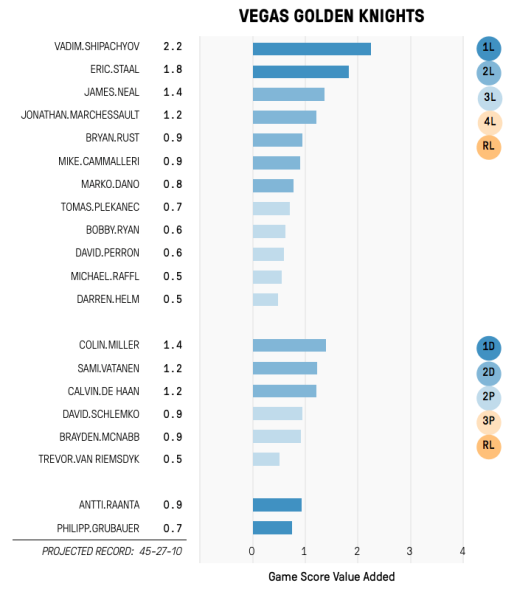
If Vegas was built on advanced stats and without any side deals, the breadth of talent available to the Golden Knights might allow them to build a playoff-contending squad right out the gates.
If Vegas was built on advanced stats and without any side deals, the breadth of talent available to the Golden Knights might allow them to build a playoff-contending squad right out the gates.
How good can the Vegas Golden Knights be in 2017-18? As good as they want to be. There’s a surprising amount of decent players who were left exposed – though there are side deals in place to steer Vegas away – that will give the new team plenty of options when it comes to building their roster.
The NHL made the expansion rules with the goal of allowing its new team to be as competitive as possible right from the start, but simply taking the best exposed player from each team is probably not a sustainable blueprint for success. The right way for Vegas to build is exactly what it appears they are doing, with young players and futures acquired by avoiding players that were left off of teams' protected lists. That’ll allow them to build a proper foundation for consistent success.
Without knowing the details of all the side deals, most mock drafts right now would be pretty tough, but what I do think would be interesting is measuring just how good this team can be based on who’s available. And that means building the entire team using just a spreadsheet.
Yeah, yeah, the game is played on the ice, not on a spreadsheet, I know, but when it comes to team-building it’s prudent to know just how valuable players are based on their on-ice results. Getting the best player usually means getting the player with the best numbers, and that’s what we’re doing here: building the Vegas Spreadsheet Knights.
The issue with that, though, is hockey data is still in its infancy and while that doesn’t make stats obsolete, it does mean there’ll be blind spots of which to be mindful. Some guys might be better than they look, some guys might be worse. That’s why you need hockey people and the nerds working together to see what each side is missing.
I don’t see any hockey people around, so here’s the nerd side of things. According to just the numbers*, this is the best cap-compliant team Vegas can make along with their Game Score from last season.
*Disclaimer: Despite it always being written like that, “The Numbers” isn’t a set-in-stone gospel. It really depends on how the person looking at them interprets them. What it actually means here is that this is the best team based on numbers that I’m looking at and it could be totally different for a different person, even if they’re looking at the same numbers. Remember this anytime someone writes, “the numbers say…” because they’re not saying anything, the observer is.

This looks like a pretty good team to me, and Vadim Shipachyov is the only free agent signing of the bunch. The allure of Matt Dumba is tempting in Minnesota, especially with his age, and that seems like the direction Vegas should go, but for a team of best players it’s hard to not pick a guy like Eric Staal who bounced back and played like a No. 1 center this season. With Staal in between James Neal and Mike Cammalleri, the Golden Knights would have a pretty decent top line despite their lack of star power. With Shipachyov, Tomas Plekanec and Darren Helm down the middle, their center position could actually be a point of strength.
Shipachyov is the big wild card here and I think a lot of people are underestimating the Knights because his play is so difficult to account for. We haven’t seen him yet, all we know is he lit up the KHL with 76 points in 50 games. That’s an NHL equivalent of 92 points, which is absurd. Alex Radulov, for reference, was at 74 in 2015-16. After age-adjusting and regressing, I figured Radulov was good for 60 points and he ended up playing at a 58-point pace. For Shipachyov, somewhere between 65 to 70 might be more accurate. He’s really good.
The wingers aren’t bad either, with 30-goal scorer Jonathan Marchessault in the fold along with David Perron and two-time Cup winner Bryan Rust.
The defense looks decent from front to back, although they’re obviously missing a top tier D-man. I’m still amazed Calvin de Haan wasn’t protected instead of Adam Pelech (???) even if there is a side deal, as I’d imagine the price of that deal would go down if their positions were reversed. Choosing between Sami Vatanen and Josh Manson from Anaheim is a tough call, but I think there’s value in having a power play quarterback of Vatanen’s caliber in the fold.
In net are two solid backups ready for a bigger role in Antti Raanta and Philipp Grubauer, who might be as good as Marc-Andre Fleury already, making him redundant, allowing us to take one of Pittsburgh’s many decent forwards.
All right, so how good is this team? Apparently, apparently, my model – which we used during the season for playoff and Stanley Cup odds and did a good job at that – believes this team is a true-talent 100-point, top-10 team. Yeah.

Crazy, right? Is this model on bath salts? Is it time for it to be thrown in the garbage? I can already see the comments from the future and they’re not pretty. Everyone expects the Golden Knights to be pretty bad right off the bat, but here’s some egghead claiming this group of outcasts without much star power can be… actually… good? That doesn’t add up. I mean, the team does look pretty good, but contender in Year 1? Feels far-fetched.
Here’s why it might not be: depth. Few teams will be deeper than this one. They may not have the best top line or defense pairing, but their second, third or fourth wave of players will be on par – or better – than what most teams can ice. Other teams will have guys dragging down the team on their bottom lines and pairings, but not Vegas, whose worst players can very well be true-talent third-liners or second-pairing defensemen. That’s a luxury very few teams can afford and puts them in a great position to succeed. If this team wins it’ll be because the bottom of their lineup is a matchup nightmare.
But that’s also why it may be wrong. A lot of these players aren’t used to playing up the lineup and they may just crash and burn as a result. Remember the blind spots I mentioned earlier? One issue with this model is measuring context which is difficult to completely account for. That’s especially true for defensemen as Colin Miller and Brayden McNabb look like the real deal, but that’s mostly because they get sheltered from tough usage. They have high value, but it’s possible that drops in tougher minutes.
With that in mind there’s definitely reason to be skeptical here. This model is reasonably good at measuring players and teams, but it has never encountered a situation like this with a team full of players who’ve yet to play with each other. The interactions with former teammates or away from stiff competition may be lingering in their results (ie. how much of Rust’s value is The Crosby Effect) and propping them up to look better than they actually are.
But even if the belief is that this model over-estimates Vegas’ ability, there’s still enough of a cushion to say that at their best, the Golden Knights can absolutely be a playoff team in their very first year. Lop off eight points from their projection for potential error and it’s still a 92-point team, which puts them pretty close to a 50/50 shot for the playoffs.
The real Vegas Golden Knights won’t look like this, we already know that thanks to all the side deals. The point is that the players available to them are actually decent. They are good enough to make other teams make side deals to keep them in the fold, and good enough that Vegas could ice a very good roster – if that’s what they wanted to do.
Want more in-depth features and expert analysis on the game you love? Subscribe to The Hockey News magazine.
